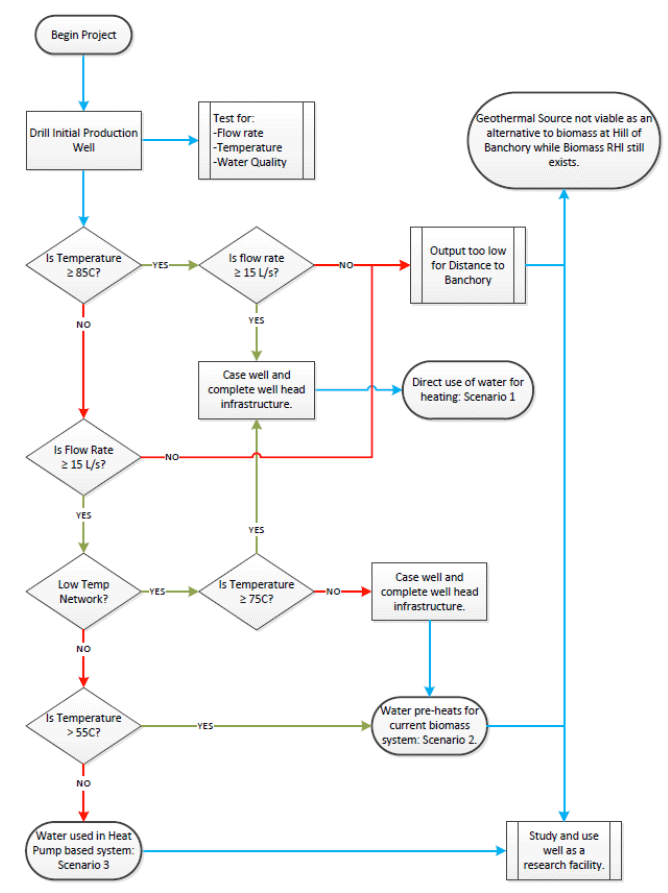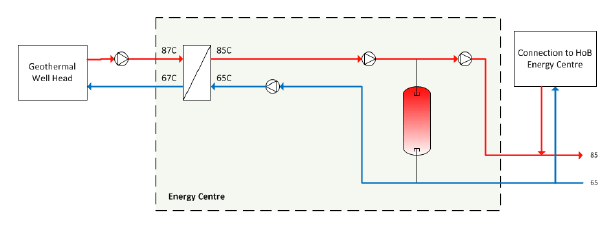Hill of Banchory geothermal energy project: feasibility report
Report of a study which explored the potential for a deep geothermal heat project at the Hill of Banchory, Aberdeenshire.
12. Preliminary Heat Network Design Considerations
To be compatible with the customer heating system the geothermal heat supply must achieve specified parameters of flow and return (F/R) temperatures. With no upgrades to customer heating systems the network F/R temperatures would need to achieve 85/60°C. If customer upgrades to properties facilitated a low temperature network then 75/45°C may be achievable. A range of potential scenarios were evaluated at a high level for variations in flow rates and source temperatures to determine the most suitable type of heating system. This included a brief discussion on the pros and cons of each specific solution and the scenarios were then colour-coded based on their simplicity, cost of heat, and heat production capability as seen in Table 14.
Table 12: Summary and Evaluation of heating solutions for potential heat production scenarios at the Hill of Fare
| Heat Available From Geothermal Resource |
||||
|---|---|---|---|---|
| Source Temp From Geothermal Well |
<45°C |
<75°C |
>75°C |
>85°C |
| Achievable ΔT |
10 |
≈20 |
30 |
20 |
| System Description |
Not sufficient for low temperature network. Heat pump system used but lower delta T achievable due to lower source temperature. |
Not sufficient for low temperature network. Heat exchangers and upgrade boilers used to meet final flow temp requirements. |
Direct heating if network is altered to operate at low temperatures. |
Suitable for direct heating in scheme with normal operating temperatures. |
| Cost Evaluation |
More expensive heating system required and lower delta T and therefore COP increases cost of heat. |
More expensive heating system, but no retrofitting is required. Extra cost of heat upgrade will increase as source temp decreases |
Low equipment CAPEX but high modification costs as the system requires new buildings and all retrofit connections to be designed / refurbished for low temperature. |
Cheap and Simple system with little to no building fabric work required. Can integrate with existing HOB scheme easily. |
| Flow = 5 l/s |
Insufficient flow to operate a viable system. Only 314kW available. |
Insufficient flow to operate a viable system. Only 627kW available. |
Insufficient flow to operate a viable system. Only 418kW available. |
Insufficient flow to operate a viable system. Only 630kW available. |
| Flow = 15 l/s |
Insufficient flow to operate a viable system. Only 941kW available. |
Could produce approximately 1.25MW. However heat will be more expensive. |
Approximately 1.9MW available, therefore cost of heat limited to 0.5p minimum |
Approximately 1.25MW available therefore would require a higher cost of heat. |
| Flow = 30 l/s |
Could produce approximately 1.8MW. However heat will be more expensive. |
Could produce approximately 2.5MW. However heat will be more expensive. |
3.8MW available: Geothermal system has high enough capacity to cover costs if demand is available. |
2.5MW available: Geothermal system has high enough capacity to cover costs if demand is available. |
| Flow = 50 l/s |
Could produce approximately 3.7MW. However heat will be more expensive. |
Could produce approximately 4.25MW. However heat will be more expensive. |
Best case assumptions, 6.3MWth available, System has high enough capacity to cover costs if demand is available. |
Best case assumptions, 4.25MW available, System has high enough capacity to cover costs if demand is available. |
Table 14 would inform a second phase of the project if a test borehole is commissioned and used to highlight the preferred system design based on more accurate temperature and flow data. A flow chart further illustrating this process can be seen in Figure 35 below.
Figure 35: Heating System Decision Flow Chart

Summary of Technical Solutions
Direct Heating
This is the simplest heating system design that could be employed at Banchory involving high capacity heat exchangers installed in the energy centre to extract heat from the geothermal fluid and transfer it into the network. However as there is no additional heat input, it would require the most favourable operating conditions, i.e. the source temperature would have to be above the network flow temperature. This becomes less likely for higher flow temperatures as the chances of obtaining that temperature decreases.
Figure 36: Simplified system schematic for direct geothermal heating in Banchory

Image: Ramboll Energy
Geothermal Pre-heating
If the temperature from the resource is below the required network flow temperature, good use could still be made of the geothermal energy by pre-heating the network flow and upgrading it using boilers to meet the desired network temperatures. The design of this type of system would depend on the return temperatures that can be achieved in the network since the source temperature would need to be higher than network return temperatures to have any pre-heating effect.
High Source Temperature Heat Pump
It might be the case that the Hill of Fare granite can produce reasonably high flow rates, but at a much lower temperature than is required for direct heating. If the source temperature were to be close to or below the network return temperature, then it would be impossible to utilise any of the heat directly regardless of the flow (as the heat transfer is dependent on temperature difference).
One way to solve this problem and utilise the geothermal energy could be a heat pump.
To utilise more than just 5 degrees of delta T on the source side, an unbalanced flow heat exchanger could be utilised to warm an intermediate loop acting as the cold side input to the heat exchanger. This would extract 10°C from the geothermal source but only raise the heat pumps input by 5°C by utilising a larger flow on that side. Figure 37 below shows an indicative set of conditions under which this may be used.
Figure 37: Unbalanced flow heat exchanger to increase source-side temperature drop

Conclusions
Although it was initially assumed that an existing network would be a positive asset to a future geothermal project, modelling has shown that existing operating parameters may constrain the ability of a new geothermal system to link-in and supply additional heat. Furthermore with the existing Hill of Banchory Network already receiving renewable energy generation, in the form of biomass, which benefits from a low cost base and government subsidy via the Renewable Heat Incentive, it makes it difficult for an alternative renewable resource to displace an existing renewable resource.
Whilst the existing circumstances for the Hill of Banchory Heat Network perhaps make this a somewhat exceptional case, were a similar geothermal system to be analysed as a standalone opportunity, or against fossil fuels as the alternative fuel, it could be a much more financially viable option. The prospect in Banchory of an expanded network beyond the scope of the existing scheme could present such an opportunity.
Contact
There is a problem
Thanks for your feedback